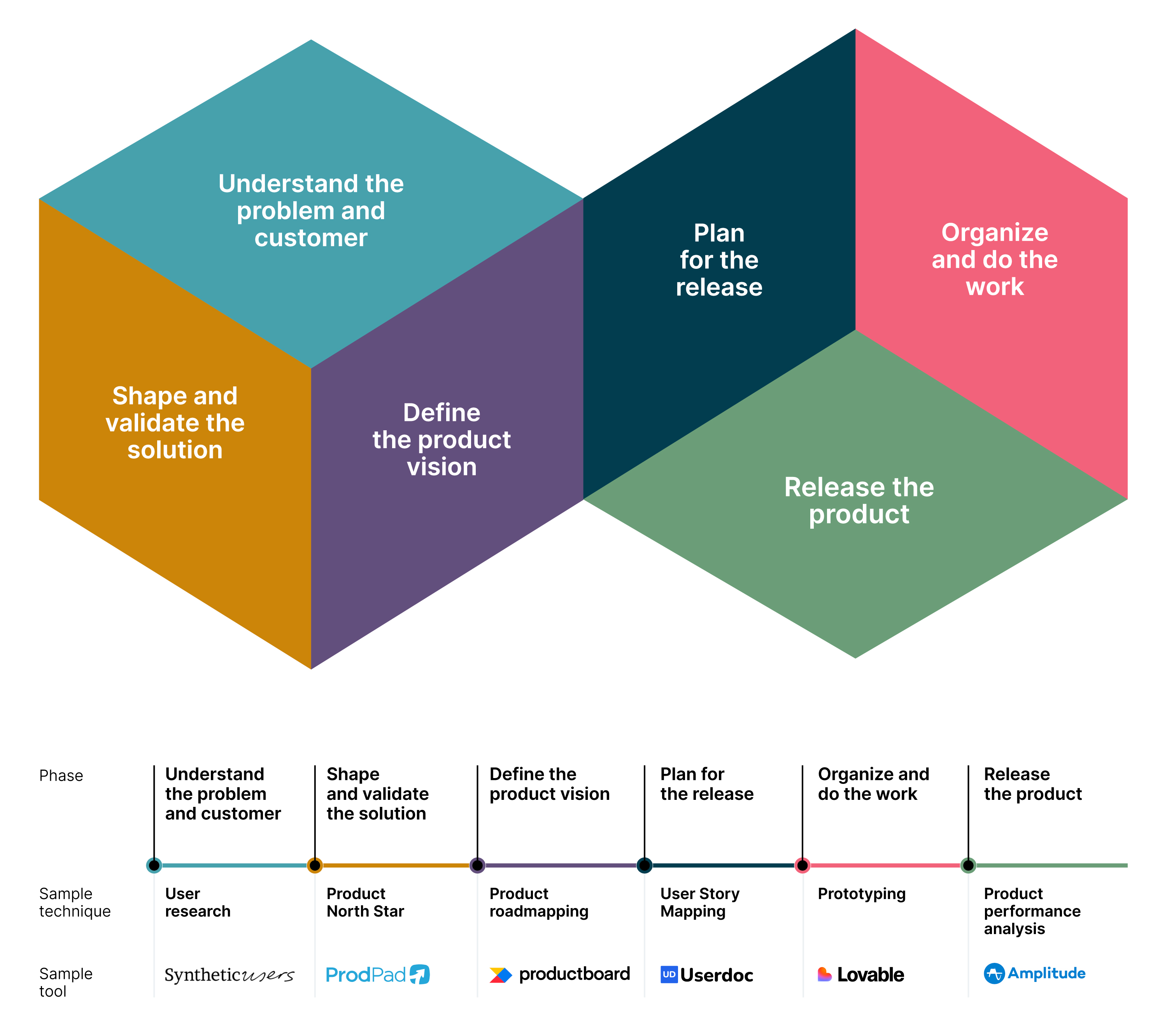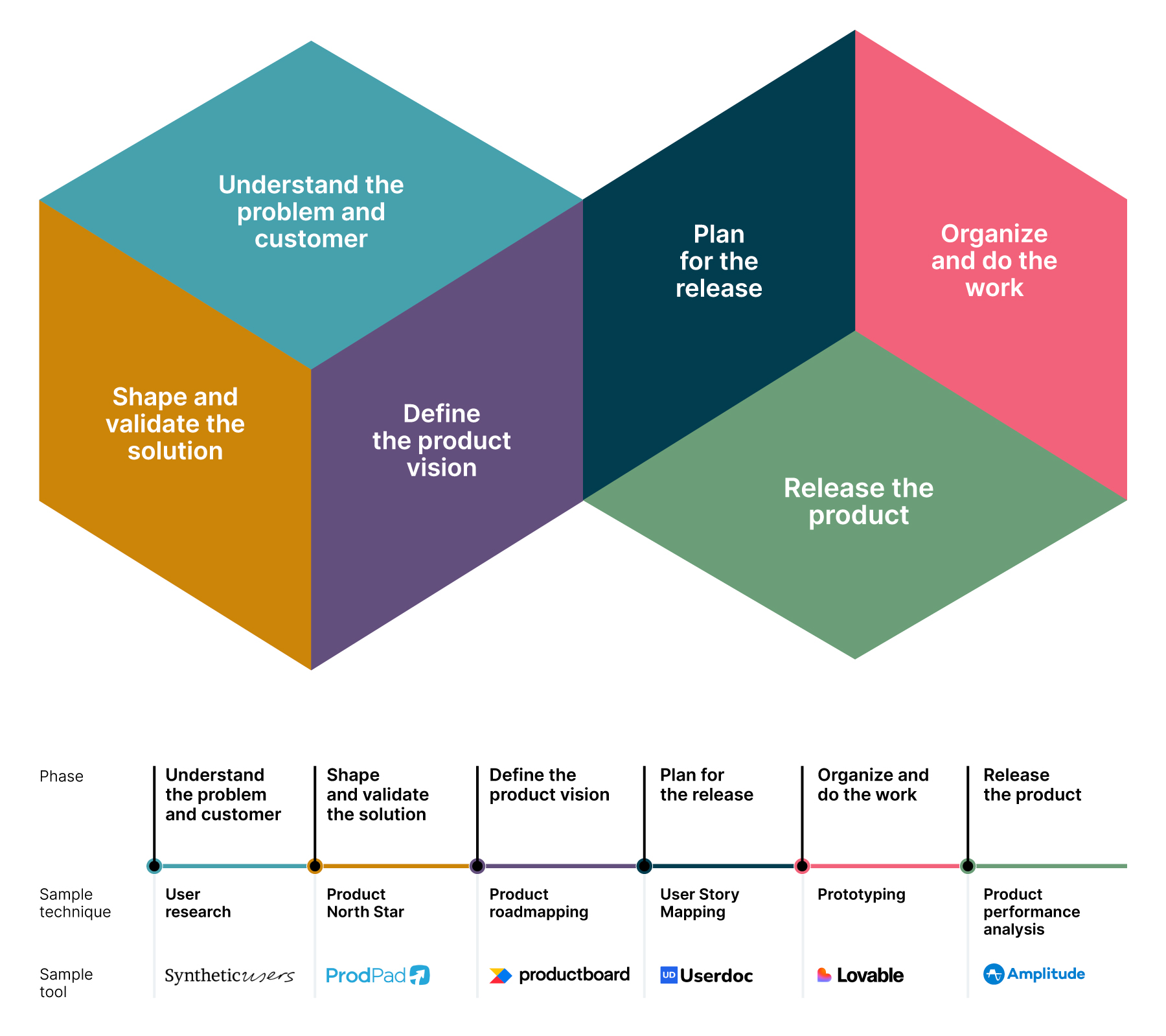If you aren’t prototyping with AI, you’re doing it wrong.
Aparna's statement hits at the heart of the transformation that has already taken place at the top product companies.
Generative AI is no longer an optional tool in product development; it's a core team member. Research from Harvard Business School confirms what many are seeing firsthand: AI tools can not only help teams produce more balanced solutions, but can also fulfil some of the social and motivational roles traditionally offered by human teammates.
Yet even as generative AI becomes indispensable, many product leaders still struggle with how to implement it in the face of rapidly evolving work dynamics.
This blog offers leaders a practical starting point to realize its full potential. We unpack proven applications of generative AI in product development, where to focus investment and how to effectively equip teams for this shift.
Inside, you’ll find:
What product teams are already achieving with generative AI
How to choose your generative AI toolkit
Your AI-powered product team
Crucial skills to foster on your team
The real value of generative AI tools
What product teams are already achieving with generative AI
Across industries, we’ve seen five high-impact generative AI use cases emerge on teams. For product leaders at the start of their journey, these are great places to begin exploring adding value:
Supporting divergent thinking: Generative AI can generate broad sets of possibilities at any stage of product development, including ideas and concepts. This helps produce more well-rounded exploration of a problem or solution space, whether used by a team or an individual.
We used this approach with a global tech company to identify and shape new opportunities across their product portfolio. Through our Generative AI Product Accelerator, powered by GenAI tools such as Elai and Storyboardhero, we quickly created detailed concept presentations for multiple product ideas, ultimately advancing one focused on conversational business intelligence.
Bridging knowledge gaps: Generative AI can fill in knowledge gaps and surface potential pitfalls early, flagging design or technical risks that may arise from executing on a strategy. This empowers individuals to explore, develop and validate their ideas without having to wait for a team member with a specific skill set. When connected to internal knowledge systems, it helps teams make context-aware decisions.
We use GenAI tools for technical code reviews and generation of unit tests, exponentially accelerating coding. We have also found that these tools can instantly answer technical questions that would normally take us weeks of tracking down the right team to answer — greatly reducing cross-domain dependencies. All general-purpose LLMs will help in this area, but are most valuable when integrated with your workspace. We frequently use Gemini and Glean as they're integrated with our Google workspace.
Enhancing research synthesis: Generative AI tools can rapidly analyze large datasets, extract insights from user feedback and summarize competitive landscapes, giving you more time to spend with your customers and to focus on strategic decision-making.
Notably and Kraftful are two examples of tools in this space, but integrated products like Miro with their Insights offering may also work for teams.
Rapid prototyping: Generative AI allows teams to quickly express, iterate on and validate ideas. This is especially helpful for product managers who want to bring ideas to life for discussion without investing in coding.
Tools such as Lovable and v0 now allow teams to write code and produce high-fidelity prototypes in minutes based on just a text prompt.
Adapting communication: Product leaders often need to communicate the same idea in many different ways for different audiences, internally and externally. Teams can use generative AI for tweaking the delivery while maintaining the core message, using examples of what good looks like in their context.
All general-purpose LLMs will do this, but tools such as Grammarly and Jasper are built specifically to support communication.
How to choose your generative AI toolkit
Adopting generative AI tools now will help you learn which ones suit your needs and what kinds of work they’re best at. There is no shortage of specialized tools for every stage of product development. There’s even a tool to help you find the right AI tool.
A few examples are shown here:


Some guidelines for adopting generative AI tools in product development:
Tools are rapidly improving and adding new features, so keep in mind that limitations you encounter may be resolved quickly.
Don’t overlook the tools that are already part of your workflow. Many have already integrated generative AI features: Figma and Miro are examples of product tools that have leaned into AI features as part of their core offering.
Even general-purpose LLMs like ChatGPT, Gemini or Claude can be a good starting point and support a wide range of tasks across your team.
Your AI-powered product team
As we integrated generative AI into our work, we quickly noticed that it wasn’t just saving us time; it was reshaping how work gets done and by whom.
The more generative AI supports execution, the more traditional product roles start to blur. Engineers may get support synthesizing user feedback, or directly use AI to validate an interesting feature idea they coded. Product managers may start with prototypes instead of documents.
Even in large organizations, where responsibilities tend to be more siloed, AI is creating new overlap and interaction across disciplines. With natural language as the primary interface, AI tools already feel and act like team members — consulting, collaborating and exchanging knowledge in real time.
Building AI-powered product teams isn’t just a technical shift; it’s cultural. It changes how and when we collaborate with each other. To ensure a successful transition, leaders should:
Help teams understand where the company is headed and what that means for individuals. This includes when and how they’re expected to use AI, what the future of work might look like and how that will impact their role. Companies like Shopify and Duolingo recently published AI guidance for employees.
Set an example by using AI tools in their own work and sharing publicly — even when it results in sub-optimal outcomes at first. This encourages teams to experiment and fail on their own, catalyzing learning.
Encourage cross-disciplinary collaboration and learning across all areas that impact the product: design, engineering, product, data science, growth, marketing, behavioral economics and more.
Treat AI tool use as a core competency, not just a specialized role on the team.
Ensure policies are in place to protect your and your customers’ intellectual property and mitigate other risks including bias and hallucinations.
Engage in critical thinking without tools, to challenge AI-generated solutions and continue to develop this key skill.
Crucial skills to foster on your team
While AI is changing the way we approach product development, some fundamentals remain constant or become even more important. Here’s what product leaders must continue to cultivate on their teams as they explore the generative AI frontier:
1. Clear communication
Clear communication has always been a pillar of strong product work, and with AI in the mix, it’s even more critical. The results of AI-augmented work depend on the inputs, even as the tools get better at determining intent. Vague instructions often lead to unintended consequences.
Although prototyping tools can generate impressive results without much input, this doesn’t lead to competitive advantage when anyone can subscribe and learn to use them better.
2. Organizational contextualization
Every organization builds products a little differently, shaped by its industry, goals, org chart, processes and culture. Whether you follow delivery/discovery frameworks such as Scrum, SAFe, Less, Shape Up or your own product development methods, your organizational context impacts what and how your teams ultimately deliver.
AI doesn’t automatically have or understand this context. It doesn’t know your team's priorities, how decisions are made or why certain trade-offs are non-negotiable in your industry. It will certainly get better as you bring it into more spaces, but that context always starts with you.
To get real value from AI, you need to enrich its output with all the context you have built up through experience — whether that’s in your instructions, in where you choose to use it, or how you validate its output.
3. Product sense
Generative AI can generate ideas, summarize information and suggest next steps, but it cannot experience your product as your customers do, or empathize with them. These are critical activities on the path to developing product sense and judgment.
Personally, AI-synthesized research notes leave me feeling like I’m missing part of the picture unless I take part in some of the research.
Just like team members can interpret the same data differently, AI offers just one perspective — you still have to do the work of bringing market research, customer research, technology and consumer expectations together in a unique, hard-to-copy way. That’s when innovative products emerge.
The real value of generative AI tools
The biggest potential of generative AI is not productivity gains; it’s a shift in how teams approach product development.
With AI generating ideas, concepts, prototypes and code, the limiting factor becomes not engineering capacity, but product strategy and discovery — making sure you are building the right thing. The big questions become: How do you prioritize ideas? What is worth validating?
AI tools can help teams build more, faster, but without a strong product strategy, that speed can send you in the wrong direction. The real value comes when AI is guided by value metrics rather than productivity metrics.
It's equally important to recognize that AI may not always be the right answer. Some tasks still demand empathy, judgment, human connection, predictability and security, and are better served with traditional software tools and expertise.
One company that recently re-evaluated this is Klarna, the Swedish fintech. After shifting heavily to AI in customer service, they reversed course. Now, they’re reinvesting in people — because, in their words, “in a world of automation, nothing is more valuable than a truly great human interaction.”
“leo” also demonstrates a viral example of learning in public when generative AI tools may not be the right solution:


As you move toward building AI-powered teams, remember:
Context and integration are critical for outsized value driven by generative AI tools.
Honing certain core skills is just as important as ever, maybe even more so.
Transforming the way you build products with generative AI is where competitive advantage will come from — creating more value, not simply building the same way but faster.
Being intentional, instead of using AI indiscriminately, will yield better results.
Parts two and three of this blog series (coming soon) will dive deeper into what those new ways of working look like — and how to avoid the pitfalls that trip up even the best teams.
Until then, hear more in Appmixer’s podcast AI in the Product Manager's Toolbox with Ivana Ciric, where we dig into the human side of this transformation and what it means for product leaders today.
Disclaimer: The statements and opinions expressed in this article are those of the author(s) and do not necessarily reflect the positions of Thoughtworks.



















